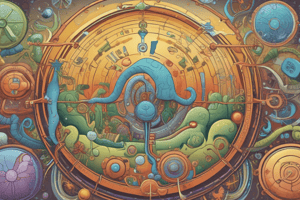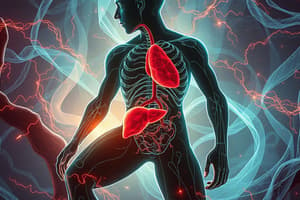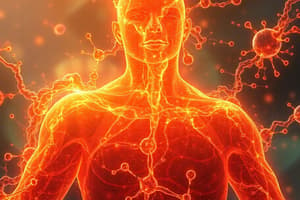Podcast
Questions and Answers
What happens to the rate of amino acid degradation during starvation?
What happens to the rate of amino acid degradation during starvation?
- It decreases significantly.
- It increases significantly. (correct)
- It fluctuates depending on the individual's metabolism.
- It remains unchanged.
Low levels of circulating insulin during starvation lead to what effect on the adipocytes?
Low levels of circulating insulin during starvation lead to what effect on the adipocytes?
- Increased glucose transport, resulting in decreased fatty acid and TAG synthesis.
- Decreased glucose transport, resulting in increased fatty acid and TAG synthesis.
- Increased glucose transport, resulting in increased fatty acid and TAG synthesis.
- Decreased glucose transport, resulting in decreased fatty acid and TAG synthesis. (correct)
Which of the following is NOT a direct consequence of increased amino acid degradation during starvation?
Which of the following is NOT a direct consequence of increased amino acid degradation during starvation?
- Increased urea cycle activity.
- Increased ketone body production.
- Increased synthesis of new proteins. (correct)
- Increased production of glucose through gluconeogenesis.
What is the primary role of adipose tissue during starvation?
What is the primary role of adipose tissue during starvation?
Which of the following best describes the relationship between insulin and fatty acid synthesis?
Which of the following best describes the relationship between insulin and fatty acid synthesis?
What primarily triggers hepatic glycogenolysis?
What primarily triggers hepatic glycogenolysis?
After how many hours of fasting does the liver glycogen become exhausted?
After how many hours of fasting does the liver glycogen become exhausted?
What is hepatic glycogenolysis primarily characterized as?
What is hepatic glycogenolysis primarily characterized as?
What happens to glycogen stores in the liver during the first 8-12 hours of fasting?
What happens to glycogen stores in the liver during the first 8-12 hours of fasting?
What role does hepatic glycogenolysis play during fasting?
What role does hepatic glycogenolysis play during fasting?
What is the process that produces fatty acids from stored TAGs in adipose tissue?
What is the process that produces fatty acids from stored TAGs in adipose tissue?
How are fatty acids transported in the blood after being released from adipose tissue?
How are fatty acids transported in the blood after being released from adipose tissue?
What role does glycerol play after being released during the hydrolysis of TAGs?
What role does glycerol play after being released during the hydrolysis of TAGs?
Which statement about the release of fatty acids is true?
Which statement about the release of fatty acids is true?
What is the primary tissue involved in producing glycerol for gluconeogenesis?
What is the primary tissue involved in producing glycerol for gluconeogenesis?
What occurs in muscles after they decrease their use of ketone bodies?
What occurs in muscles after they decrease their use of ketone bodies?
What happens to the levels of circulating ketone bodies as muscles shift energy sources?
What happens to the levels of circulating ketone bodies as muscles shift energy sources?
Which metabolic change occurs as muscles oxidize fatty acids instead of ketone bodies?
Which metabolic change occurs as muscles oxidize fatty acids instead of ketone bodies?
What is a potential consequence of muscles excluding ketone bodies from their energy metabolism?
What is a potential consequence of muscles excluding ketone bodies from their energy metabolism?
Why might muscle cells prefer fatty acids over ketone bodies at certain times?
Why might muscle cells prefer fatty acids over ketone bodies at certain times?
What role do amino acids play in blood glucose maintenance?
What role do amino acids play in blood glucose maintenance?
What is gluconeogenesis primarily dependent on for blood glucose regulation?
What is gluconeogenesis primarily dependent on for blood glucose regulation?
Which of the following statements is true regarding hepatic gluconeogenesis?
Which of the following statements is true regarding hepatic gluconeogenesis?
What is a consequence of the rapid breakdown of muscle proteins?
What is a consequence of the rapid breakdown of muscle proteins?
Which process supplies substrates for the liver to produce glucose?
Which process supplies substrates for the liver to produce glucose?
What is the primary source of amino acids for gluconeogenesis during the initial stages of starvation?
What is the primary source of amino acids for gluconeogenesis during the initial stages of starvation?
Which organ is primarily responsible for gluconeogenesis during the initial stages of starvation?
Which organ is primarily responsible for gluconeogenesis during the initial stages of starvation?
What is the main function of gluconeogenesis during the first few days of starvation?
What is the main function of gluconeogenesis during the first few days of starvation?
Which of the following statements is TRUE about protein metabolism during the initial stages of starvation?
Which of the following statements is TRUE about protein metabolism during the initial stages of starvation?
What is the consequence of the rapid breakdown of muscle protein during the initial stages of starvation?
What is the consequence of the rapid breakdown of muscle protein during the initial stages of starvation?
Flashcards
Hepatic Glycogenolysis
Hepatic Glycogenolysis
The process of breaking down glycogen stored in the liver into glucose, providing a quick source of energy for the body.
Transient Response to Early Starvation
Transient Response to Early Starvation
The body's immediate response to a lack of food, where the liver releases stored glucose to fuel basic functions.
Liver Glycogen Exhaustion
Liver Glycogen Exhaustion
The liver's glycogen reserves are depleted, leading to the body seeking alternative energy sources after prolonged fasting.
Glycogen Exhaustion Timeframe
Glycogen Exhaustion Timeframe
Signup and view all the flashcards
Adaptive Metabolism During Prolonged Fasting
Adaptive Metabolism During Prolonged Fasting
Signup and view all the flashcards
Amino Acid Degradation During Starvation
Amino Acid Degradation During Starvation
Signup and view all the flashcards
Insulin's Role in Fat Cell Metabolism
Insulin's Role in Fat Cell Metabolism
Signup and view all the flashcards
Fat Synthesis During Starvation
Fat Synthesis During Starvation
Signup and view all the flashcards
Adipose Tissue's Role in Starvation
Adipose Tissue's Role in Starvation
Signup and view all the flashcards
Fuel Source Switch in Starvation
Fuel Source Switch in Starvation
Signup and view all the flashcards
TAG Hydrolysis
TAG Hydrolysis
Signup and view all the flashcards
Albumin
Albumin
Signup and view all the flashcards
Fatty Acids as Fuel
Fatty Acids as Fuel
Signup and view all the flashcards
Glycerol's Role
Glycerol's Role
Signup and view all the flashcards
Gluconeogenesis
Gluconeogenesis
Signup and view all the flashcards
Hepatic Gluconeogenesis
Hepatic Gluconeogenesis
Signup and view all the flashcards
Muscle Protein Breakdown
Muscle Protein Breakdown
Signup and view all the flashcards
Amino Acids as Energy Source
Amino Acids as Energy Source
Signup and view all the flashcards
Priority of Gluconeogenesis
Priority of Gluconeogenesis
Signup and view all the flashcards
Maintaining Blood Glucose
Maintaining Blood Glucose
Signup and view all the flashcards
Ketone Body Shift during Fasting
Ketone Body Shift during Fasting
Signup and view all the flashcards
Muscle Ketone Dependence
Muscle Ketone Dependence
Signup and view all the flashcards
Ketone Accumulation
Ketone Accumulation
Signup and view all the flashcards
Adaptive Fat Oxidation
Adaptive Fat Oxidation
Signup and view all the flashcards
Elevated Ketone Levels and Fat Oxidation
Elevated Ketone Levels and Fat Oxidation
Signup and view all the flashcards
What happens to muscle protein during early starvation?
What happens to muscle protein during early starvation?
Signup and view all the flashcards
Gluconeogenesis during starvation
Gluconeogenesis during starvation
Signup and view all the flashcards
Why does muscle protein breakdown occur during starvation?
Why does muscle protein breakdown occur during starvation?
Signup and view all the flashcards
Why are amino acids from muscle protein important during starvation?
Why are amino acids from muscle protein important during starvation?
Signup and view all the flashcards
What is the primary fuel source during early starvation?
What is the primary fuel source during early starvation?
Signup and view all the flashcards
Study Notes
Integrated Metabolism During Starvation
- Starvation is the deprivation of food, water, and salts
- It can arise from:
- Inability to obtain food (e.g., famine)
- Desire to lose weight rapidly
- Clinical situations (e.g., brain trauma, burns)
- Political strikes
- Chronic anorexia (e.g., anorexia nervosa)
- Recorded survival times:
- Food: 3-4 weeks, potentially up to 9-10 weeks with significant fat stores
- Water: 7-10 days
- Salts: 2 weeks
Role of the Liver During Starvation (High Glucagon/Insulin Ratio)
-
Carbohydrate Metabolism:
- The liver initially maintains blood glucose by increasing glycogen degradation (glycogenolysis)
- Then, it increases gluconeogenesis
- Hepatic glycogenolysis is a temporary response to early starvation; liver glycogen is depleted after 8-12 hours of fasting.
- Gluconeogenesis begins 4-6 hours after the last meal, and becomes fully active when liver glycogen stores are depleted.
-
Fat Metabolism:
- Increased fatty acid oxidation (influenced by glucagon and catecholamines) from lipolysis
- Increased ketone body synthesis, particularly beta-hydroxybutyric acid
- Ketone bodies become the primary fuel source for tissues (including the brain) when their concentration in the blood is high enough. This decreases the need for gluconeogenesis from amino acids.
-
Amino Acid & Protein Metabolism:
- Increased breakdown of amino acids (protein degradation)
Role of Adipose Tissue During Starvation
- Carbohydrate Metabolism:
- Low insulin levels inhibit glucose transport into adipocytes, thus decreasing fatty acid and TAG synthesis
- Fat Metabolism:
- Increased TAG degradation (influenced by decreased insulin, increased glucagon, and catecholamines, activating hormone-sensitive lipase)
- Increased release of fatty acids:
- Hydrolysis of stored TAGs releases fatty acids into the blood, where they bind to albumin
- Fatty acids are transported to various tissues for use as fuel and glycerol, used as a gluconeogenic precursor by the liver.
Role of Skeletal Muscles During Starvation
- Carbohydrate Metabolism:
- Inhibition of glucose transport into muscles, due to low insulin levels
- Fat Metabolism:
- In the first two weeks of starvation, muscles use fatty acids from adipose tissue and ketone bodies from the liver.
- After this, they oxidize fatty acids almost exclusively, leading to a continued increase in circulating ketone bodies.
Role of the Brain During Starvation
- Initial phase:
- The brain exclusively uses glucose.
- Blood glucose is maintained through hepatic gluconeogenesis using amino acids from broken-down muscle proteins.
- Prolonged Phase (>2-3 Weeks):
- Plasma ketone bodies reach elevated levels and become the primary fuel source for the brain
- This reduces the need for protein catabolism (used for gluconeogenesis).
Protein Metabolism During Starvation
- Rapid muscle protein breakdown in the first few days to provide amino acids for gluconeogenesis.
- Organs lose varying amounts of protein based on function/vitality. Common examples of protein lost during starvation include:
- Brain(3%)
- Muscle(30%)
- Liver(50%)
- Spleen (70%)
- Adipose tissue(100%)
- Degradation rate decreases after several weeks due to reduced need for glucose
- Glucocorticoids control degradation rate.
Studying That Suits You
Use AI to generate personalized quizzes and flashcards to suit your learning preferences.




